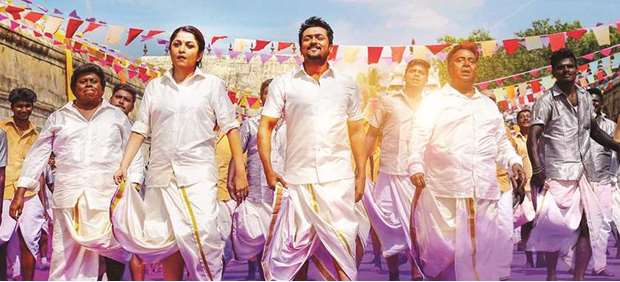Time was when I felt peeved that Tamil cinema was called regional – and Hindi movies national. In fact, at a recent conclave of southern Indian film industry, the legendary auteur, Adoor Gopalakrishnan, who creates meaningful movies in Malayalam, rued the fact that all languages except Hindi was being described as regional. This must stop. For, Hindi cannot be a national language. It can only be one of the official Indian languages – like Bengali or Punjabi or Telugu or Tamil or Assamese. There are 22 today, including English.
But having said this and having been believing this for years, I would also have to confess that most of the films that emerge from the Bollywood stable – usually in Hindi – tend to be far better than those that are made in Tamil Nadu and in Tamil. In fact, except for Malayalam cinema, the movies in the three other southern Indian languages – Tamil, Kannada (from the State of Karnataka) and Telugu (Andhra Pradesh) – are often poor in just about every department.
Whether it be script or direction or cinematography or direction or acting, Tamil cinema – as also Kannada and Telugu – leaves much to be desired. Yes, Tamil films are strong in story, and the novelty of themes can be amazing. But then, everything gets lost in conceptualisation and execution, and one very important reason for this is also the lopsided way of budgeting. If a producer has to shell out 60 per cent or even more of the total budget for an actor, nay a star, the man with the purse has very little left for the other areas of production. So, I am not surprised that a Tamil or a Kannada or a Telugu movie begins to look awful on screen. Somehow, Kerala producers have managed to get their budgeting right, and they have also been able to keep many of their films within the realm of reality.
Here is a glaring example of how a Tamil movie remade from an original Hindi version was ruined by lack of artistic imagination.
Give a Tamil producer, writer or director Shakespeare, and he will transform it into “therukkoothu” or “nautanki”. He will make the film loud, verbose (like a bad television serial) and garish. His hero and heroine will have to change the costume at every step or every turn of a song. The writer and the helmer will have to explain every action through a pile of words – as if the average Tamil viewer is dumb.
I was pained to see how Neeraj Pandey’s riveting Special 26 – with Akshay Kumar, Anupam Kher, Manoj Bajpayee, Jimmy Shergill, Kajol Aggarwal and Divya Dutt – has been messed up by writer/director Vignesh Shivan in his Tamil remake, Thaanaa Serndha Koottam with Suriya in the lead.
While Pandey drew a splendidly subtle performance from even a star like Akshay to present a 1980s plot, inspired by the famous 1987 Bombay Opera House heist where a group of men had posed as Central Bureau of Investigation (CBI) officers, Shivan borrows the story and embellishes it with several songs (which literally push the narrative off the track), tap dances, fight sequences, emotional tear-jerking scenes and a morally preachy climax.
But of course! Suriya cannot be seen committing a crime, and when he does, he has to have a heart-wrenching reason. Also, he must take the moral high ground – or this is what I understand. But Akshay could not care about his image, and he is no less a star than Suriya. Akshay could not be bothered about what his fans thought of his character. He was a thief in Special 26, and he had no compunctions about it. When his lover, Priya (Kajol), gently reminds him that he is but only a “chor”, he quips with a sardonic smile, “but I am not capable of doing anything else”. He does not suffer from any pangs of guilt.
But Suriya’s Iniyan – who like Akshay’s Ajay Ajju Singh – poses as a CBI officer after having failed to get into the force – carries his troubled conscience on his shoulders, and he has to explain why it is not wrong to rob Peter to help Paul. In the Tamil version, Iniyan is a philanthropist. Not Ajay in Special 26.
Special 26 had some lilting numbers, and its romantic track ran on the sidelines, shorn of any exaggeration, and it melted beautifully into the primary plot. Thaanaa Serndha Koottam has no great music to take home, is weighed down with innumerable sub-texts: we have Iniyan’s father (Thambi Ramiah), a clerk in the police department, whose honesty robs the son of a CBI placement, we have a Madhu (Iniyan’s girlfriend essayed by Keerthi Suresh), who looks after elderly destitute and is an epitome of charity; we have a Kurinjivendhan (a real CBI officer, portrayed by Karthick), who fits into Bajpayee’s shoes in the original, but makes a mockery of a part that the Hindi actor turned so memorable; and we have a Ramya Krishnan (stepping in for Kher), as a fake CBI officer, Jhansi Rani, who cannot let go her Baahubali expressions.
Undoubtedly, the casting is all wrong in the Tamil version, and Suriya does not let himself sink into the character. He wants to play hero, which Akshay also did, but so differently and with such dignity. Suriya robs the CBI of all its decorum, behaves more like a roadside thug, punching and beating up dozens of adversaries – so unlike a CBI officer, so unlike what Akshay gave us.
Thaanaa Serndha Koottam tells us the tale of some failed men, who decide that wealth can only be had through ill-gotten means, and they go about posing as CBI officers, raiding Government Ministers, rich men and jewellers – all of whom had stashed away money made by evading taxes or through bribery. Finally, Kurinjivendhan gets on their trail, and does a most unprofessional job of nabbing them. And, I cannot believe the offer he gives to Iniyan, a reward for his robberies.
Honestly, a great story and script like Special 26 have been marred beyond belief, and Shivan’s idea of infusing his movie with juvenile wit at every step reduces Thaanaa Serndha Koottam into a meandering mishmash.
* Gautaman Bhaskaran has been writing on Indian and world cinema for close to four decades, and he may be emailed at [email protected]

DISAPPOINTMENT: In Thaanaa Serndha Koottam, a great story and script like Special 26 have been marred beyond belief.


